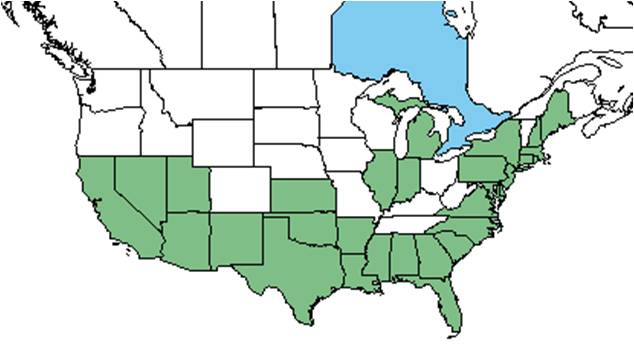Difference between revisions of "Pluchea odorata"
KatieMccoy (talk | contribs) |
KatieMccoy (talk | contribs) (→Seed dispersal) |
||
| Line 35: | Line 35: | ||
===Seed dispersal=== | ===Seed dispersal=== | ||
| + | Seeds are dispersed by wind (Alyokhi et al. 2001). | ||
| + | |||
===Seed bank and germination=== | ===Seed bank and germination=== | ||
===Fire ecology=== <!--Fire tolerance, fire dependence, adaptive fire responses--> | ===Fire ecology=== <!--Fire tolerance, fire dependence, adaptive fire responses--> | ||
Revision as of 14:12, 22 February 2016
| Pluchea odorata | |
|---|---|
Error creating thumbnail: Unable to save thumbnail to destination
| |
| Photo taken by Gil Nelson | |
| Scientific classification | |
| Kingdom: | Plantae |
| Division: | Magnoliophyta - Flowering plants |
| Class: | Magnoliopsida – Dicotyledons |
| Order: | Asterales |
| Family: | Asteraceae |
| Genus: | Pluchea |
| Species: | P. odorata |
| Binomial name | |
| Pluchea odorata (L.) Cass. | |

| |
| Natural range of Pluchea odorata from USDA NRCS Plants Database. | |
Common name: sweetscent, marsh fleabane
Contents
Taxonomic notes
Description
A description of Pluchea odorata is provided in The Flora of North America.
Distribution
It is distributed from southern Maine south to Florida, west to Texas and beyond, it is a largely coastal species[1]. It is an exotic weed in Hawaii, and is considered to be a serious problem (Alyokhin et al. 2001).
Ecology
Habitat
Pluchea odorata can be found in salt marshes, mangrove swamps, river banks, cypress swamps, marl prairies, cabbage palmetto-water hickory hammocks, pine flatwoods, coastal hammocks, and hickory mounds. It has also been found in disturbed areas such as calcareous borrow pits, roadside depressions, clear-cut pine flatwoods and drainage canals. Soil types include loamy sand, loam, and alluvial soils. Associated species include Cyperus, Juncus, Fuirena, Rhynchospora, Penthorum sedoides, Pluchea foetida, Boehmeria, Saururus, Pilea, and Murdannia keisak (FSU Herbarium).
Phenology
It has been observed flowering April through December (FSU Herbarium). It exhibits crystallofolia, which is an unusual feathery or ribbon like ice formation that appears on a plant during frost events when water is emitted along the steam during freezing[2].
Seed dispersal
Seeds are dispersed by wind (Alyokhi et al. 2001).
Seed bank and germination
Fire ecology
Pollination
The following Hymenoptera families and species were observed visiting flowers of Pluchea odorata at Archbold Biological Station (Deyrup 2015):
Apidae: Mellisodes communis
Halictidae: Halictus poeyi, Lasioglossum nymphalis
Megachilidae: Anthidium maculifrons, Coelioxys germana, C. sayi, Dianthidium floridiense
Sphecidae: Ammophila procera
Vespidae: Leptochilus republicanus, Zeta argellaceum
Use by animals
Diseases and parasites
Conservation and Management
Cultivation and restoration
Photo Gallery
References and notes
Deyrup, M.A. and N.D. 2015. Database of observations of Hymenoptera visitations to flowers of plants on Archbold Biological Station, Florida, USA.
Florida State University Robert K. Godfrey Herbarium database. URL: http://herbarium.bio.fsu.edu. Last accessed: October 2015. Collectors: Loran C. Anderson, L. Baltzell, Jane Brockmann, D. Burch, N. Chevalier, William J. Clark, G. Crosby, Delzie Demaree, R.F. Doren, G. Fleming, P. Genelle, Robert K. Godfrey, Norlan C. Henderson, C. Jackson, R. Komarek, O. Lakela, Robert L. Lazor, Robert J. Lemaire, R. Kral, Sidney McDaniel, Richard S. Mitchell, John Morrill, Jackie Patman, R.A. Norris, James D. Ray, Grady W. Reinert, Danielle Sherdan, Cecil R. Slaughter, Sydney Thompson, D.B. Ward, S.S. Ward. States and Counties: Florida: Bay, Brevard, Broward, Citrus, Clay, Collier, Dixie, Flagler, Franklin, Hillsborough, Indian River, Jackson, Jefferson, Lake, Lee, Leon, Levy, Manatee, Monroe, Marion, Okeechobee, Orange, Osceola, Palm Beach, Pasco, Putnam, St. Lucie, Taylor, Wakulla. Countries: Belize, Cayman Islands. Compiled by Tall Timbers Research Station and Land Conservancy.